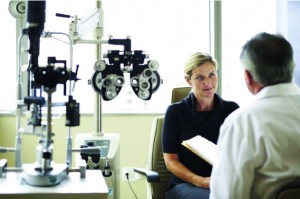By Lauren R. Rosecan, M.D., Ph.D., F.A.C.S.
 A subconjunctival hemorrhage is similar to an ordinary bruise on the skin — it’s like a bruise of the eye. It usually appears as a single, concentrated spot of red, or many scattered red splotches, on the white of the eye. The redness is blood under the conjunctiva, a clear membrane that covers the white of the eye (called the sclera) and the inner eyelids.
A subconjunctival hemorrhage is similar to an ordinary bruise on the skin — it’s like a bruise of the eye. It usually appears as a single, concentrated spot of red, or many scattered red splotches, on the white of the eye. The redness is blood under the conjunctiva, a clear membrane that covers the white of the eye (called the sclera) and the inner eyelids.
Seeing a subconjunctival hemorrhage on your eye can be alarming. Yet it is actually a common minor occurrence. It is almost always harmless and will heal on its own. It does not affect vision and generally does not cause pain. There are usually no sensations or symptoms, other than the appearance of the red spot. In fact, you may not even be aware that you have a subconjunctival hemorrhage until someone points it out or you look in the mirror.
Subconjunctival Hemorrhage Causes
The conjunctiva contains many blood vessels and capillaries, the tiniest blood vessels in the body. These vessels can break, causing blood to leak between the conjunctiva and the sclera. This minor bleeding under the eye’s outer membrane is what causes the bright red spot to appear on the white of the eye.
The most common causes are coughing, sneezing, straining, or any similar action that temporarily raises blood pressure in the veins, leading to a small rupture in a blood vessel or capillary. Subconjunctival hemorrhage can also occur because of trauma to the eye —
even minor trauma such as rubbing the eye vigorously.
Other common but less frequent causes of subconjunctival hemorrhage include diabetes mellitus, high blood pressure, and excessive amounts of certain medications such as aspirin or blood thinners like warfarin (Coumadin®), which affect the body’s bleeding mechanisms.
Much less frequent to rare causes may include blood clotting disorders or other systemic blood disorders.
If you have recurrent or excessive subconjunctival hemorrhages, your ophthalmologist (Eye M.D.) will examine your eyes, assess your risk factors and order appropriate laboratory studies, if needed, sometimes in collaboration with your primary care physician.
Treatment of a subconjunctival hemorrhage is generally not necessary. Over time, the blood spot will slowly disappear, clearing up on its own. This may take days or weeks, depending on the size of the blood spot. If your eye is irritated, your ophthalmologist may recommend that you use over-the-counter artificial tears.
In general, if you have a subconjunctival hemorrhage, you can expect your ophthalmologist to reassure you that the blood spot will go away. Although subconjunctival hemorrhage can seem alarming, it is usually a temporary, harmless condition that your Eye M.D. can assess appropriately for you.
Lauren R. Rosecan
M.D., Ph.D., F.A.C.S.
The Retina Institute of Florida with four offices
conveniently located in Palm Beach and Martin Counties.
Toll Free Phone Number:
1-800-445-8898
561-832-4411
West Palm Beach
901 North Flagler Drive, 33401
(561) 832-4411 Office
(561) 832-1591 Fax
Palm Beach Gardens
11382 Prosperity Farms Rd., #128, 33410
(561) 627-7311 Office
(561) 627-6791 Fax
Stuart
618 East Ocean Blvd., #3, 34994
(772) 287-7026 Office
(772) 220-4186 Fax
Boca Raton
1050 NW 15th Street, #114, 33486
(561) 368-7723 Office
(561) 368-0093 Fax
Check Also
WHAT IS MY CIRCADIAN RHYTHM AND WHY DOES IT MAKE ME FEEL SO “OFF”
By Renee Chillcott, LMHC Have you heard terms such as “biological clock” or “biorhythms”, or …
 South Florida Health and Wellness Magazine Health and Wellness Articles
South Florida Health and Wellness Magazine Health and Wellness Articles




